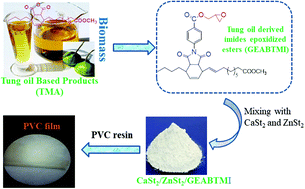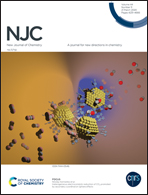Construction of efficient tung-oil-based thermal stabilizers bearing imide and epoxy groups for PVC
Abstract
In the present work, tung-oil-derived imide epoxidized esters (GEABTMI) were prepared and used as poly(vinyl chloride) (PVC) co-stabilizers. Characterization results confirmed the successful preparation of the targeted material. The thermal stabilizing effects of CaSt2/ZnSt2/GEABTMI (St: stearic acid) were compared with those of CaSt2/ZnSt2/ABTMI {ABTMI: N-(3-amino-benzoic acid) tung-maleimides} and CaSt2/ZnSt2. The experimental results showed that of the materials tested, CaSt2/ZnSt2/GEABTMI could provide the best long-term thermal stability for PVC. According to the thermal stability results and characterization, the simultaneous introduction of imide and epoxy groups into the GEABTMI structures was responsible for the excellent performance of the stabilized PVC. Furthermore, a mechanism for the stabilization of the PVC/CaSt2/ZnSt2/GEABTMI system was proposed. According to this proposal, the imide groups trapped the labile chlorine atoms removed from the PVC chain and reacted with the unstable macromolecular radical of PVC, disrupting in this way the radical chain degradation of PVC; and the epoxy group acted as an HCl absorber at the subsequent stages of degradation, avoiding in this way the harmful effects caused by the presence of HCl. Apart from the better stabilization performance, CaSt2/ZnSt2/GEABTMI yielded a PVC plasticization performance similar to those resulting from the use of the other stabilizers.



 Please wait while we load your content...
Please wait while we load your content...